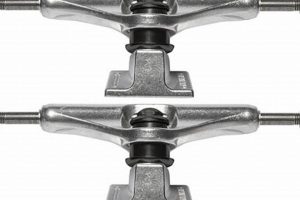These devices, also known as wheel dollies, facilitate the movement of vehicles with disabled or missing wheels. They are positioned under the tires, effectively transforming the vehicle into a rolling platform. As an illustration, mechanics might employ these tools to maneuver a car within a cramped repair shop.
The utilization of these aids offers several advantages. They enable the effortless repositioning of vehicles in situations where conventional movement is impossible. This capability saves time and reduces the physical strain associated with pushing or lifting heavy objects. Historically, simpler versions have been used in automotive repair and recovery for decades.
The following sections will delve deeper into the specific applications, types, and purchasing considerations relevant to these indispensable tools. Detailed analysis of load capacity, wheel compatibility, and material durability will be provided.
Practical Guidance for Using Tire Skates
The efficient and safe employment of vehicle dollies necessitates adherence to specific guidelines. Maximizing usability and minimizing risk requires careful consideration of the following points.
Tip 1: Assess Load Capacity: Prior to use, verify that the selected units possess an adequate weight rating for the vehicle in question. Exceeding the stated limit can result in structural failure and potential injury.
Tip 2: Ensure Wheel Compatibility: Different models are designed to accommodate various wheel diameters and widths. Confirm compatibility to guarantee secure and stable support.
Tip 3: Utilize on Level Surfaces: The devices are most effective and safest when operated on even, flat ground. Sloped or uneven surfaces increase the risk of slippage and instability.
Tip 4: Secure Locking Mechanisms: If equipped with locking casters or brakes, engage them firmly after positioning the vehicle to prevent unintended movement.
Tip 5: Distribute Weight Evenly: When positioning the dollies, ensure the vehicle’s weight is distributed equally across all units for optimal stability.
Tip 6: Inspect Regularly: Conduct routine inspections for signs of wear, damage, or loose components. Address any issues promptly to maintain operational safety.
Tip 7: Use in Pairs or Sets: To avoid uneven pressure or tilting, always use these tools in pairs or complete sets corresponding to the number of wheels on the vehicle.
Adhering to these guidelines will facilitate the safe and effective maneuvering of vehicles, protecting personnel and equipment from potential harm.
The subsequent sections will explore advanced techniques and troubleshooting strategies relevant to specific operational scenarios.
1. Load Capacity
Load capacity is a paramount consideration in the context of vehicle dollies. It represents the maximum weight a set of devices can safely and reliably support. Exceeding this limit poses a significant risk of structural failure, leading to potential damage to the vehicle, the dollies themselves, and possible injury to personnel. Therefore, careful calculation and adherence to the manufacturer’s specified weight rating is indispensable for safe operation. For example, a set designed for standard passenger cars should not be utilized for heavy-duty trucks, which require a significantly higher capacity rating.
The relationship between load capacity and wheel dollies extends beyond a simple safety measure. It also impacts performance and longevity. Overloading not only increases the immediate risk of catastrophic failure but also accelerates wear and tear on the dollies’ components, such as casters and frame. This can lead to decreased maneuverability, increased maintenance requirements, and a shortened overall lifespan. Conversely, selecting a product with an appropriate load capacity ensures smooth and efficient operation, contributing to enhanced productivity in automotive repair and storage applications.
In summary, understanding and respecting load capacity is not merely a guideline but a fundamental requirement for the responsible and effective use of vehicle dollies. It ensures safety, optimizes performance, and extends the lifespan of the equipment. A failure to account for load capacity can lead to serious consequences, highlighting the practical significance of meticulous selection and responsible operation.
2. Wheel Diameter
The wheel diameter parameter directly influences the functionality of vehicular dollies. The receiving platform of the skate must accommodate the external diameter of the tire being supported. If the tire diameter exceeds the physical limits of the device, secure and stable support is compromised. This can result in an unstable platform, increasing the risk of the vehicle slipping off the skate during maneuvering. Consider, for example, a compact unit designed for standard passenger car tires being used with the larger tires of an SUV; the mismatch in dimensions could lead to instability and potential damage.
Furthermore, the overall ground clearance provided by the dollies is affected by wheel diameter. A smaller diameter tire positioned on a dolly increases the total height, potentially creating clearance issues when moving the vehicle in confined spaces, such as low-ceiling garages or workshops. Conversely, a significantly larger wheel diameter might necessitate a broader support platform on the dolly, potentially impacting the dolly’s portability and storage. Manufacturers often provide specifications for the acceptable wheel diameter range, as these influence load distribution and stability.
In conclusion, proper consideration of wheel diameter is not merely a detail, but a critical factor determining the safety and efficiency of vehicular dolly use. Failure to match the dolly’s design parameters to the vehicle’s tire dimensions introduces substantial risk, while careful selection optimizes maneuverability and ensures safe operation. Accurate measurements and adherence to manufacturer specifications are essential for informed application.
3. Surface Friction
Surface friction plays a crucial role in the effectiveness and safety of tire skates. The coefficient of friction between the skate’s wheels and the underlying surface dictates the force required to initiate and maintain movement. High friction can impede rolling efficiency, demanding greater effort to maneuver a vehicle. Conversely, insufficient friction can result in uncontrolled slippage, particularly on sloped surfaces, leading to potential accidents or damage. The selection of caster materials and the texture of the floor surface directly influence this interaction. For example, hard plastic casters on a polished concrete floor will exhibit lower friction than rubber casters on a textured asphalt surface.
The relationship between surface friction and these devices extends beyond mere ease of movement. It directly impacts stability and control during relocation. When moving a vehicle on an incline, the static friction between the skate and the floor must be sufficient to prevent unintended rollback. Similarly, during turns, a balanced frictional force is necessary to maintain the intended trajectory and prevent lateral slippage. The optimal surface friction also considers load distribution, as uneven weight can exacerbate friction-related issues. A heavy load concentrated on a single skate could increase the risk of slippage if the friction coefficient is insufficient.
In summary, understanding and managing surface friction is paramount for safe and efficient use. Selecting appropriate caster materials and ensuring suitable floor conditions are essential considerations. Insufficient friction jeopardizes control and safety, while excessive friction increases effort and reduces maneuverability. A balanced approach, tailored to the specific application and load requirements, optimizes performance and minimizes risk. The material selection and floor condition both affect the safe use of tire skates.
4. Material Durability
Material durability constitutes a critical attribute of vehicular dollies. The choice of materials directly impacts the lifespan, load-bearing capacity, and overall safety of the equipment. Inferior materials are susceptible to premature wear, deformation under load, and ultimately, catastrophic failure. Consider, for example, dollies constructed with low-grade steel frames and plastic casters. These are prone to bending, cracking, and caster failure under the weight of heavier vehicles, rendering them unusable and potentially hazardous. In contrast, dollies fabricated with high-strength steel frames and robust, reinforced casters demonstrate significantly enhanced resistance to deformation and wear, ensuring a longer service life and safer operation.
The importance of material durability extends beyond the immediate cost of replacement. Equipment failure can lead to vehicle damage, personal injury, and downtime in automotive repair settings. For instance, a collapsing dolly could cause a vehicle to drop unexpectedly, damaging its undercarriage or surrounding equipment, while also posing a serious risk to personnel. Investing in dollies constructed from durable materials, such as hardened steel, impact-resistant polymers, and high-quality bearings, mitigates these risks. Regular inspection and maintenance further contribute to extending the lifespan and ensuring the continued reliability of the equipment. The type of caster material and welding techniques must withstand high stress levels.
In summary, material durability is not merely a desirable feature of vehicular dollies; it is a fundamental requirement for safe and effective operation. The selection of durable materials minimizes the risk of equipment failure, protects personnel and property, and reduces long-term operating costs. A thorough understanding of material properties and rigorous quality control measures are essential for ensuring the reliability and longevity of these essential tools.
5. Caster Locking
Caster locking mechanisms are integral to the safe and efficient operation of tire skates. These locks, typically engaged via a foot pedal or lever, prevent the casters from rotating, effectively immobilizing the skate and, consequently, the vehicle it supports. The absence of a reliable locking system presents a significant safety hazard, as unintended movement of the vehicle can result in collisions, injuries, or damage to property. For example, when performing repairs on a vehicle elevated on dollies, disengaging the caster locks could cause the vehicle to roll unexpectedly, potentially crushing limbs or damaging surrounding equipment. The presence of functional caster locks transforms the skate from a mobile platform into a secure support, crucial for tasks requiring stability.
The application of caster locking extends beyond simple immobilization. In certain situations, such as maneuvering a vehicle on a slightly sloped surface, strategically locking specific casters can assist in maintaining the desired trajectory. By preventing rotation on one or more dollies, directional control is enhanced, reducing the risk of uncontrolled drift. Moreover, when storing vehicles in confined spaces, engaging all caster locks ensures that the vehicles remain stationary and prevents them from shifting or colliding with other objects. The robustness and reliability of the locking mechanism are, therefore, paramount, requiring regular inspection and maintenance to ensure proper functionality. Corrosion, debris accumulation, or mechanical wear can compromise the locking system, necessitating timely repair or replacement.
In conclusion, caster locking is not merely an optional feature; it is a fundamental safety component of tire skates. It provides stability, enhances control, and prevents unintended movement, all of which are essential for safe and efficient vehicle handling. Regular maintenance and adherence to manufacturer’s guidelines are critical to ensuring the continued reliability of these locking mechanisms, thereby mitigating the risks associated with vehicle relocation and storage. Proper selection of skates should include a thorough assessment of the locking system’s design and durability.
6. Maneuverability
Maneuverability is a core attribute directly linked to the utility of tire skates. These devices are expressly designed to facilitate the relocation of vehicles within confined spaces, where conventional driving is impossible. The degree to which a tire skate enables efficient movement is a direct measure of its effectiveness. Restricted spaces demand high maneuverability; the easier the skates allow movement, the more useful they are in places with limited space.
The design and construction of tire skates significantly influence maneuverability. For instance, skates equipped with swivel casters provide a greater range of motion than those with fixed wheels. Similarly, the diameter and material composition of the casters impact rolling resistance and turning ease. In a crowded automotive repair shop, the ability to quickly and precisely reposition a vehicle using highly maneuverable skates can save time, reduce physical strain on technicians, and minimize the risk of collisions with other equipment. Conversely, skates with poor maneuverability may require excessive force to operate, increasing the potential for accidents and inefficiencies.
In summary, maneuverability is a critical determinant of the practical value of tire skates. Skates that offer superior maneuverability empower users to navigate tight spaces with greater ease and precision, enhancing productivity and safety. The relationship between design features, such as caster type and wheel material, and overall maneuverability must be carefully considered when selecting appropriate equipment. Prioritizing maneuverability ensures that tire skates fulfill their intended purpose of simplifying vehicle relocation in challenging environments.
7. Storage Space
The consideration of storage space in relation to vehicular dollies is a practical concern for automotive professionals and enthusiasts alike. The efficient management of available storage areas necessitates careful assessment of the space occupied by such equipment when not in use. The subsequent points detail considerations regarding storage.
- Foldability and Collapsibility
Some designs incorporate mechanisms for folding or collapsing, reducing the overall footprint when stored. Folding models are advantageous in environments where space is at a premium, such as small garages or service bays. These designs often prioritize compactness over ultimate load capacity.
- Stackability
Certain dollies are designed to be stacked upon one another, either nested or with interlocking features. This allows multiple units to occupy a smaller vertical volume. The stackable designs are beneficial in larger facilities where multiple sets are required, as this configuration consolidates storage and improves organization.
- Wall-Mounting Options
Some manufacturers offer wall-mounting accessories for their dollies. This provides an alternative to floor storage, freeing up valuable floor space. Wall mounting is best suited for environments with available vertical wall space and can enhance accessibility to the equipment.
- Weight and Portability
The weight of the individual units influences the ease with which they can be moved and stored. Lighter units are easier to lift and maneuver, facilitating convenient storage in overhead or otherwise less accessible locations. However, the pursuit of lightweight design must not compromise structural integrity and load-bearing capacity.
Ultimately, the optimal storage solution depends on the specific constraints of the available space and the frequency of use. Evaluating these factors ensures efficient utilization of resources and contributes to a well-organized work environment. The choice of vehicular dolly should consider the storage constraints along with the load and usability requirements.
Frequently Asked Questions Regarding Tire Skates
The following addresses common inquiries and misconceptions pertaining to the use and application of vehicle dollies, aiming to provide clarity and informed guidance.
Question 1: What are the primary applications of tire skates?
The primary applications involve the maneuvering of vehicles within confined spaces, such as repair shops, showrooms, and parking facilities, where conventional driving is impractical or impossible. Additionally, these are frequently utilized for vehicle recovery and repositioning after accidents or breakdowns.
Question 2: What factors determine the appropriate load capacity?
The load capacity should equal or exceed the gross vehicle weight (GVW) of the vehicle being supported. Exceeding the stated load capacity can lead to structural failure and pose significant safety risks. Consult the vehicle’s manufacturer specifications to determine the GVW.
Question 3: Are tire skates suitable for all types of vehicles?
No, compatibility depends on factors such as tire diameter, vehicle weight, and ground clearance. Certain models are specifically designed for passenger cars, while others are engineered for heavier vehicles like trucks and SUVs. Selecting an inappropriate model can compromise stability and safety.
Question 4: What maintenance is required?
Regular inspection of casters, frames, and locking mechanisms is essential. Lubrication of moving parts, tightening of loose fasteners, and replacement of worn components are also necessary to ensure optimal performance and safety. Corrosion should be addressed promptly.
Question 5: How does surface condition affect performance?
Smooth, level surfaces provide the most efficient and stable operation. Uneven or sloped surfaces increase the risk of slippage and require greater effort to maneuver. Rough surfaces can accelerate wear on casters and reduce maneuverability. The surface’s material directly affects performance and safety.
Question 6: Is professional training required to operate tire skates safely?
While formal certification is not typically mandated, proper training and adherence to manufacturer’s guidelines are crucial. Understanding load limits, safety precautions, and operating procedures minimizes the risk of accidents and ensures efficient utilization of the equipment.
The key takeaways include selecting appropriate models based on vehicle specifications, conducting regular maintenance, and prioritizing safety during operation. Adherence to these guidelines maximizes the utility and longevity of vehicle dollies.
The subsequent section will explore emerging trends and innovations in tire skate technology.
Conclusion
This exposition has detailed the functionality, application, and critical considerations surrounding tire skates. These devices represent essential tools for vehicle maneuvering in confined environments. Key aspects examined include load capacity, wheel compatibility, surface friction, material durability, caster locking mechanisms, maneuverability, and storage considerations. A thorough understanding of these elements is paramount for safe and effective utilization.
Responsible implementation of tire skates necessitates adherence to manufacturer guidelines, regular maintenance, and a commitment to safety protocols. As automotive technology evolves, ongoing advancements in tire skate design and materials are anticipated. Continued research and development will likely focus on enhancing load capacity, improving maneuverability, and incorporating smart features. Prioritizing safety and efficiency in the selection and use of these tools remains paramount for automotive professionals.







